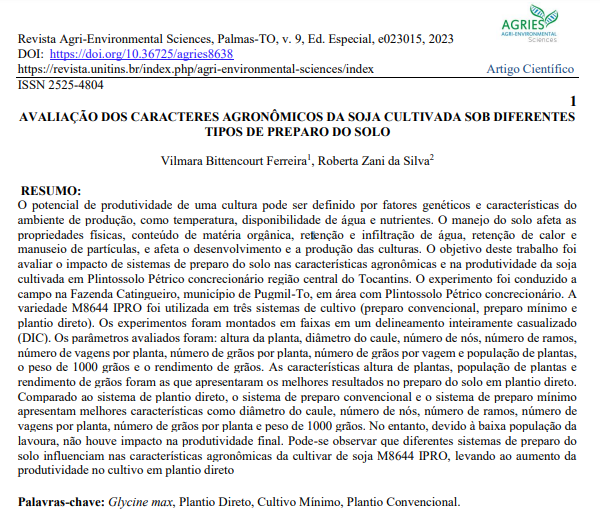AGRONOMIC CHARACTERS EVALUATION OF CULTIVATED SOYBEAN USING DIFFERENT TYPES OF SOIL TILLAGE
Abstract
The crop's productivity potential can be defined by genetic factors and characteristics of the production
environment, such as temperature, water availability and nutrients. Soil management affects physical
properties, organic matter content, water retention and infiltration, heat retention and particle handling, and
affects crop development and production. This work’s objective was to evaluate the impact of tillage systems
on the agronomic characteristics and productivity of soybean cultivated in Concretionary plinthosol in the
middle of Tocantins. The experiment was carried out in the field of Catingueiro Farm, in the city of Pugmil,
in an area with Concretionary plinthosol. The M8644 IPRO variety was used in three cropping systems
(conventional tillage, minimum tillage and no-tillage). We set up the experiments in lanes in a completely
randomized design (CRD). The evaluated parameters were: plant height, stem diameter, number of nodes,
number of branches, number of pods per plant, number of grains per plant, number of grains per pod and plant
population, 1000 grains’ weight and the grain yield. The characteristics of plant height, plant population and
grain yield were the ones that presented the best results in soil preparation in no-tillage. Compared to the no tillage system, the conventional tillage system and the minimum tillage system have better characteristics such as stem diameter, number of nodes, number of branches, number of pods per plant, number of grains per plant and weight of 1000 grains. However, due to the low crop population, there was no impact on final productivity. It is observable that different soil preparation systems influence the agronomic characteristics of the soybean cultivar M8644 IPRO, leading to increased productivity in no-tillage planting.

Copyright (c) 2023 AGRI-ENVIRONMENTAL SCIENCES

This work is licensed under a Creative Commons Attribution-NonCommercial-NoDerivatives 4.0 International License.
Copyright
Upon acceptance of a manuscript, authors will be asked to complete an "exclusive license" form that will allow the manuscript to be disclosed in the form of open access. In order to do the work of publishing and disseminating the research paper manuscript we need the rights to publish. For open access manuscripts, we use an exclusive licensing agreement where authors retain copyright from their manuscript.
In this agreement the authors retain rights to:
-Patents and other intellectual property rights in manuscript
-The right to credit for published work









